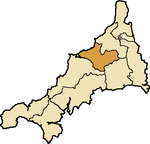Triggshire
| Trigg Hundred | |
|---|---|
  Shown within UK and Cornwall |
The hundred of Trigg (also known as Triggshire) was one of ten ancient administrative shires of Cornwall—see "Hundreds of Cornwall".
Trigg is mentioned by name during the 7th century, as "Pagus Tricurius", "land of three war hosts".[1] It was to the north of Cornwall, and included Bodmin Moor, Bodmin and the district to the west and north of the Moor50°28′16″N 4°43′01″W / 50.471°N 4.717°WCoordinates: 50°28′16″N 4°43′01″W / 50.471°N 4.717°W. The high incidence of imported pottery from the period found at Tintagel Castle suggest this was an area of high significance, where war bands from the region may have congregated.[1]
The name may be cognate with that of Trégor (Bro-Dreger) in Brittany, now northwest France. The same name is used for the ecclesiastical deaneries of Trigg Major and Trigg Minor which cover a wider area (but not identical to the historical boundaries).
The parishes of Triggshire consisted of Bodmin, Blisland, St Breward, Egloshayle, St Endellion, Helland, St Kew, St Mabyn, St Minver, St Teath, Temple, St Tudy.
Modern usage
The name Triggshire has been adopted by different clubs and organizations in the area. Triggshire Wind Orchestra, an amateur orchestra for wind players primarily from Sir James Smith's School, Wadebridge School, Budehaven School, however some students from Bodmin College and Launceston College also attend. The orchestra was set up in 1984. After the success of the wind orchestra, Triggshire String Orchestra was set up, to cater for the string players from these schools.
Triggshire Morris Men are a long established Morris Dancing club.
Literature

The historian Sir John Maclean (1811-1895) came from Trehudreth in Blisland and his "Parochial History of the Deanery of Trigg Minor" (1872-1879) in 3 volumes is the most detailed work of parochial history which deals with Cornwall (the deanery consisted of 20 parishes at the time he wrote). It was published in parts intended for binding as three volumes: there was also a separate edition of the part on Blisland. (His name was originally John Lean but he adopted that of Maclean in the erroneous belief that he had Maclean ancestors.)[2]
References
- ↑ 1.0 1.1 Morris, John (1993) The Age of Arthur: a history of the British Isles from 350 to 650. London: Weidenfeld and Nicolson
- ↑ Alan Kent (March 1993). "Sir John Maclean". Retrieved 2009-08-09.
Further reading
- Shaw, Thomas (1963) The Camelford and Wadebridge Circuit, 1743-1963 (Wesleyan Methodism and later Methodism)
External links
| ||||||||||||||||||||